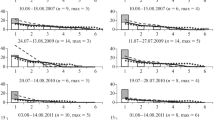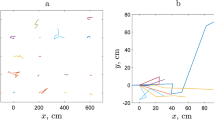Summary
The population parameters of green rice leafhopper,Nephotettix cincticeps in hibernated generation was estimated by the capture-recapture method on the gramineous weeds of resting paddy field from late in April to mid-May, 1962–1965.
The difficulty of applying the capture-recapture method to this insect is caused from the low density and the low activity of the leafhopper, so that it is necessary to make the suitable plan of capture-recapture series and to construct the special method to detect the population parameters.
The number of adults differed greatly among the years and among the plots in the same year. But, in general, the density was relatively high late in April, and decreased rapidly in May. The number of males was higher than that of females late in April, but decreased rapidly to become lower in May.
The sampling efficiency with sweep-net depends upon the many factors, such as weather and floristic conditions; especially the atmospheric temperature and the force of wind are considered to affect greatly to the efficiency. In general, low temperature and strong wind are the cause of low sampling efficiency.
Similar content being viewed by others
References
Bailey, N. T. J. (1951) On estimating the size of mobile populations from recapture data.Biometrika 38: 293–306.
Banks, C. J. andE. S. Brown (1962) A comparison of methods of estimating population density of adult sunn pest,Eurygaster integriceps Put. (Hemiptera: Scutelleridae) in wheat fields.Ent. exp. & appl.,5: 225–260.
Dempster, J. P. (1957) The population dynamics of the Morccan locust (Dociostaurus marcoccanus Thunberg) in Cyprus.Anti-Locust Bull. 27: 1–60.
Dowdeswell, W. H., R. A. Fisher andE. B. Ford (1940) The quantitative study of populations in the Lepioptera. 1.Polyommatus icarus Rott.Ann. Eug. 10: 123–136.
Esaki, T. andS. Hashimoto (1931) Report on the leaf-hoppers injurious to the rice plant and their natural enemies. No. 2.Dept. Agric., Kyushu Imp. Univ., Publication no. 2, 25·III: 1–57.
Esaki, T. andS. Hashimoto (1932)ditto, No. 3.Ibid. no. 3. 25·III: 1–42.
Fisher, R. A. andE. B. Ford (1947) The spread of the gene in natural conditions in the colony of the mothPanaxia dominula L.Heredity 1: 143–174.
Itô, Y., A. Takai, K. Miyashita andK. Nakamura (1963) Estimation of density, survival rate and dilution rate ofMecostethus magister (Orthoptera: acrididae) populations by the mark and recapture method.Res. Popul. Ecol.,5: 51–61.
Iwao, S., K. Mizuta, H. Nakamura, T. Oda andY. Sato (1963) Studies on a natural population of the large 28-spotted lady beetle,Epilachna vigintioctomaculata Motshulsky. I. Preliminary analysis of the overwintered adult population by means of the marking-and-recapture method.Jap. J. Ecol. 13: 109–117.
Jackson, C. H. N. (1939) The analysis of an animal poulation.J. Anim. Ecol.,8: 234–246.
Leslie, P. H. (1952) The estimation of population parameters from data obtained by means of the capture-recapture method. II. The estimation of total numbers.Biometrika 39: 363–388.
Leslie, P. H. andD. Chitty (1951) The estimation of population parameters from data obtained by means of the capture-recapture method. I. The maximum-likelihood equations for estimating the death-rate.Biometrika 38: 269–292.
Lloyd, Ll. (1936) Assessment of a tsetse population.Bull. ent. Res.,27: 261–267.
MacLeod, J. (1958) The estimation of numbers of mobile insects from low-incidence recapture data.Trans. R. Ent. Soc. Lond. 110: 363–392.
Nakagaki, S. (1963) Overwintering of green rice leafhopper,Nephtettix bipunctatus cincticepts Uhler.Proc. Kanto Pl. Prot. Soc. 10: 43.
Richards, O. W. andN. Waloff (1954) Studies on the biology and population dynamics of British grasshoppers.Anti-Locust Bull. 17: 1–182.
Sameshima, T. andK. Nagai (1962) Relation between the life-history of green rice leafhopper,Nephotettix cincticeps Uhler, and rice yellow dwarf propagation.Japanese Jour. Appl. Ent. Zool. 6: 267–273.
Takai, A., Y. Itô, K. Nakamura andK. Miyashita (1965) Estimation of population density of the green rice leaf-hopper (Nephotettix cincticeps Uhler) by the mark-recapture and the sweeping methods.Japanese Jour. Appl. Ent. Zool. 9: 5–12.
Author information
Authors and Affiliations
Additional information
Contribution from JIBP-PT No. 20.
Rights and permissions
About this article
Cite this article
Nakamura, K., Itô, Y., Miyashita, K. et al. The estimation of population density of the green rice leafhopper,Nephotettix cinticeps Uhler, in spring field by the capture recapture method. Res Popul Ecol 9, 113–129 (1967). https://doi.org/10.1007/BF02514919
Issue Date:
DOI: https://doi.org/10.1007/BF02514919




